Preparing Your Child for a Stress-Free Return to School After the Holidays
The holiday season is a time of joy and relaxation, but transitioning back to school after the break can be challenging for children and parents alike. To ensure a smooth and stress-free return to school, it’s important to create a plan that reestablishes routines and addresses potential anxieties. Here are some practical tips to help your child ease back into their school schedule with confidence and enthusiasm.
1. Gradually Reintroduce a School Routine
Ease your child back into a structured routine by adjusting their schedule a few days before school starts:
- Bedtime: Move bedtime earlier each night to match their school schedule.
- Wake-up time: Set alarms to help your child wake up at their usual school time.
- Meals: Reintroduce regular meal times, including a healthy breakfast, lunch, and dinner.
Consistency helps children adjust and reduces morning chaos when school resumes.
2. Review Academic Material
To refresh your child’s memory, spend some time reviewing key concepts or homework assignments:
- Read together: Revisit books or class notes from before the break.
- Practice skills: Engage in fun activities like solving puzzles or playing educational games.
- Check assignments: Ensure any holiday homework is completed on time.
This preparation helps your child feel confident and ready for their return to the classroom.
3. Organize School Supplies
Start the new semester with a clean and organized backpack:
- Declutter: Remove old papers and unnecessary items.
- Restock supplies: Replace used-up pencils, notebooks, or other essentials.
- Label items: Use labels to personalize belongings and avoid mix-ups.
A well-organized bag can help your child feel prepared and focused.
4. Set Positive Expectations
Talk to your child about the exciting aspects of returning to school:
- Reuniting with friends: Highlight the joy of seeing classmates and teachers again.
- New opportunities: Encourage your child to think about new goals or activities they want to pursue.
Maintain a positive tone to help ease any back-to-school jitters.
5. Address Anxiety and Concerns
Some children may feel nervous about returning to school. Open communication is key:
- Ask questions: Encourage your child to share their feelings or concerns.
- Provide reassurance: Remind them that it’s normal to feel a little anxious and that they’ll quickly readjust.
- Practice coping skills: Teach relaxation techniques like deep breathing or visualization to help them manage stress.
For additional support, consider resources from Child Mind Institute or HealthyChildren.org.
6. Plan for a Smooth First Day Back
Set your child up for success on their first day back:
- Prepare outfits: Lay out clothes the night before.
- Pack lunch: Prepare a nutritious lunch and snacks ahead of time.
- Review the schedule: Discuss the day’s activities to minimize surprises.
Being organized reduces morning stress and helps your child start the day on a positive note.
7. Celebrate Small Wins
Returning to school after the holidays can be a big adjustment. Celebrate your child’s achievements to keep them motivated:
- Praise effort: Acknowledge their hard work in completing homework or waking up on time.
- Offer rewards: Plan a small treat or family activity to celebrate the first week back.
Conclusion
A smooth transition back to school after the holidays is possible with thoughtful planning and a positive attitude. By reestablishing routines, addressing concerns, and celebrating progress, you can help your child feel confident and excited about returning to school.


















